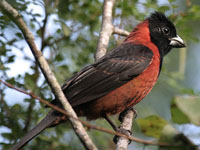THE WORLD BIRDS - An Online Bird Book
CARDINALIDAE
Grosbeaks
Order Passeriformes Family Cardinalidae
CARDINALIDAE
The Cardinalidae are a family of passerine birds found in North and South America. The family is comprised of buntings, cardinals, and grosbeaks. However, each of these categories
of birds have similary named birds in other families. The birds of this family are robust, seed-eating birds with strong bills. The family ranges in size from 12-25 cm. They are typically associated with
open woodland. The sexes are dimorphic - they usuaully have distinctive appearances.
Grosbeaks
Order Passeriformes Family Cardinalidae
See the Fringillidae family for more grosbeaks.
Genus Caryothraustes
There are only two species belonging to the Caryothraustes genus. They are predominantly yellow with black masks and heavy, grey-black bills.
Grosbeak,_Black-faced Caryothraustes poliogaster
Description: It has olive upperparts and yellow underparts with a black face and a pale-grey belly and rump.
Range: Mexico and Central America.
Habitat: Moist lowlands forests, secondary forests, woodland edges, and forest clearings. They favor the forest canopy and understory.
Consevation status: Least concern.
Range: Mexico and Central America.
Habitat: Moist lowlands forests, secondary forests, woodland edges, and forest clearings. They favor the forest canopy and understory.
Consevation status: Least concern.
Image by: 1) Cornell_Univ's_Neotropical_Birds_Online - Alex Burdo 2) Francesco Veronesi 3) Alan Harper

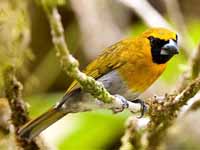
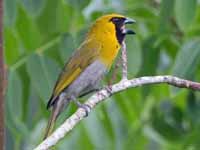
Grosbeak,_Yellow-green Caryothraustes canadensis
Description: Olive-green above, with yellow underparts and a black face.
Range: Native to north-eastern South America and Panama.
Habitat: Tropical and subtropical moist lowland forest. It also occurs in degraded former forests.
Consevation status: Least concern.
Image by: 1) Danilo Schinke 2) Cornell_Univ's_Neotropical_Birds_Online - Adrian_Eisen_Rupp 3) Nick Athanas - Brazil TibchrisRange: Native to north-eastern South America and Panama.
Habitat: Tropical and subtropical moist lowland forest. It also occurs in degraded former forests.
Consevation status: Least concern.
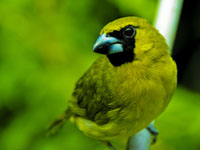

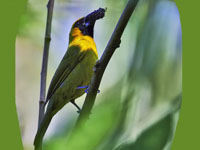
Genus Cyanocompsa
There are four species of grosbeaks in this genus. They have thick, black bills. The males have blue plumage, and the females are brown. The blue-black grosbeak and the ultramarine grosbeak are sometimes placed in the genus Cyanocompsa
Bunting, Blue Cyanocompsa parellina
Description: A small bird with a large, thick bill.The male has a rich blue plumage, with glossy blue highlights on the supercilium, forehead, cheeks, and shoulders. The female is cinnamon brown.
Range: Southwest North America, and Northern Central America
Habitat: Tropical lowland forest understory and dry, brushy woodlands.
Similar to:
* Blue Grosbeak. Blue Grosbeak has double wing bars; Blue Bunting does not. Female is plain brown.
* Indigo Bunting. Indigo Bunting has bicolored bill; Blue Bunting does not.
Consevation status: Least concern.
Image by: 1, 2) Stylurus -
Nicaragua 3) Bill Bouton - Texas 4) Dominic Sherony Oaxaca, Mexico Range: Southwest North America, and Northern Central America
Habitat: Tropical lowland forest understory and dry, brushy woodlands.
Similar to:
* Blue Grosbeak. Blue Grosbeak has double wing bars; Blue Bunting does not. Female is plain brown.
* Indigo Bunting. Indigo Bunting has bicolored bill; Blue Bunting does not.
Consevation status: Least concern.
1) Female, 2, 3, 4) Male

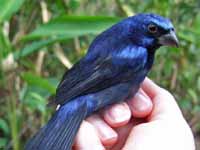
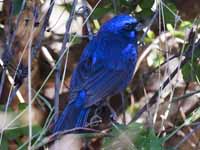

Genus Cyanoloxia
Grosbeak,_Blue-black Cyanocompsa cyanoides also Cyanoloxia cyanoides
Description: The male a dark blue plumage with a lighter forehead, supercilium, and shoulders. The female is dark reddish-brown.
Range: Central and South America
Habitat: Dense habitats with tall trees and thick undergrowth.
Consevation status: Least concern.
Image by: 1) Felix Uribe 2, 3) José Loiza - Ecuador 4) Charlie Westerinen - Poas Volcano in Costa RicaRange: Central and South America
Habitat: Dense habitats with tall trees and thick undergrowth.
Consevation status: Least concern.
1, 2) Female 3, 4) Male

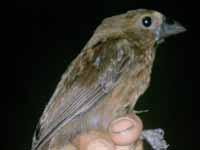

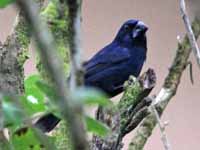
Grosbeak._Glaucous-blue also Indigo Grosbeak Cyanoloxia glaucocaerulea
Description: The male has a dull blue plumage with darker upper-wing and tail feathers. The female is reddish-brown with dark brown upperparts and a blue head.
Range: Argentina, Brazil, and Uruguay.
Habitat: Tropical and subtropical moist lowland forest and shrubland, secondary forest, riparian woodlands, and forest edges. They also occur in degraded former forests.
.
Similar to: Ultramarine Grosbeak. Blue of Ultramarine Grosbeak is darker than blue of Glaucous-blue Grosbeak. Female Glaucous-blue Grosbeak has blue head, Ultramarine Grosbeak female head is not blue.
Consevation status: Least concern.
Image by: 1, 2) Dario Sanches - Brazil 3) Nick Athanas - Brazil 4) Hector Bottai - Brazil 5) Claudio TimmRange: Argentina, Brazil, and Uruguay.
Habitat: Tropical and subtropical moist lowland forest and shrubland, secondary forest, riparian woodlands, and forest edges. They also occur in degraded former forests.
.
Similar to: Ultramarine Grosbeak. Blue of Ultramarine Grosbeak is darker than blue of Glaucous-blue Grosbeak. Female Glaucous-blue Grosbeak has blue head, Ultramarine Grosbeak female head is not blue.
Consevation status: Least concern.
1, 2) Female 3) Juvenile male 4, 5) Male


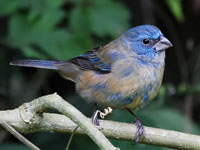
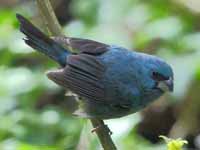
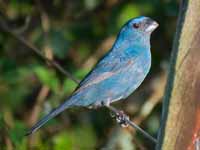
Grosbeak,_Ultramarine Cyanoloxia brissonii
Description: The male is dark blue with a glossy forehead, shoulders, cheeks, and supercilium. The upper wings and tail are darker blue. The female is reddish-brown.
Range: Central and Eastern South America with a small population in the north.
Habitat: Swamps, secondary forests, forest plantations, and semi-open areas.
Similar to: Glaucous-blue Grosbeak. Blue of Ultramarine Grosbeak is darker than blue of Glaucous-blue Grosbeak. Female Glaucous-blue Grosbeak has blue head, Ultramarine Grosbeak female head is not blue.
Consevation status: Least concern.
Image by: 1) Cláudio
Timm - Brazil 2) Michael
Kranewitter 3, 4) Nick Athanas - Brazil 5) Dario Sanches - Brazil Range: Central and Eastern South America with a small population in the north.
Habitat: Swamps, secondary forests, forest plantations, and semi-open areas.
Similar to: Glaucous-blue Grosbeak. Blue of Ultramarine Grosbeak is darker than blue of Glaucous-blue Grosbeak. Female Glaucous-blue Grosbeak has blue head, Ultramarine Grosbeak female head is not blue.
Consevation status: Least concern.
1) Juvenile 2, 3) Female 4, 5) Male

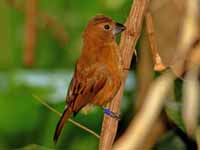
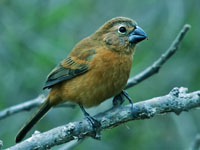
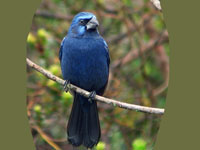
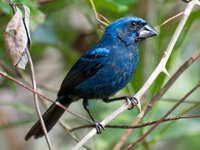
Genus Periporphyrus - 1 species
Grosbeak,_Red-and-black Periporphyrus erythromelas
Description: The male is dull red above and bright red below with a black head. The female is similar but with a yellow-green coloration in place of red.The red and black grosbeak has a large black bill.
Range: It is found in north-eastern South America.
Habitat: Tropical and subtropical moist lowland forest.
Consevation status: Least concern.
Image by: 1) Cornell_Univ's_Neotropical_Birds_Online - Gabriel LeiteRange: It is found in north-eastern South America.
Habitat: Tropical and subtropical moist lowland forest.
Consevation status: Least concern.
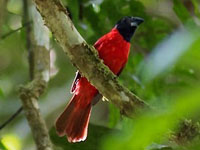
Genus Pheucticus
The genus Pheuciticus is made up of six species of grosbeaks. They have stout, conical bills. Most species are yellow and black except for the rose-breasted grosbeak.
Grosbeak,_Black-backed Pheucticus aureoventris
Description: The male has yellow underparts and a black head, breast, and upperparts, with white spots on the wings. The female has a brown head and upperparts with a speckled yellow breast.
Range: Throughout the north-western and central parts of South America.
Habitat: Woodlands, wooded scrublands, forest edges, and suburban gardens.
Similar to: Black-headed Grosbeak. Ranges do not overlap. Male Black-backed Grosbeak has a black breast; male Black-headed Grosbeak does not.
Consevation status: Least concern.
Image by: 1, 2) Nick Athanas - Ecuador 3, 4) Dick Daniels - San Diego Zoo Range: Throughout the north-western and central parts of South America.
Habitat: Woodlands, wooded scrublands, forest edges, and suburban gardens.
Similar to: Black-headed Grosbeak. Ranges do not overlap. Male Black-backed Grosbeak has a black breast; male Black-headed Grosbeak does not.
Consevation status: Least concern.
1) Female 2 - 4) Male

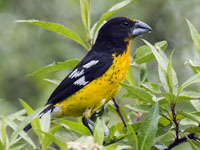


Grosbeak,_Black-headed Pheucticus melanocephalus
Description: The male is mustard-yellow with a black head and black upperparts. It has white spots on the wings and tail. The female is mostly brown with dark streaks and darker above with lighter underparts. Females have smaller wingspots.
Range: From the western United States to Mexico.
Habitat: Mixed woodlands, deciduous and coniferous forests, thickets, and suburban areas. Often near streams, rivers, and lakes.
Similar to: Black-backed Grosbeak. Ranges do not overlap. Male Black-backed Grosbeak has a black breast; male Black-headed Grosbeak does not.
Similar to: Bullock's Oriole. Male Black-headed Oriole has more black on head than male Bullock's Oriole. Male Bullock's Oriole has more white on wings.
Similar to: Rose-breasted Grosbeak. Males easy to distinguish. Black-headed Grosbeak has bicolored bill; Rose-breasted Grosbeak does not.
Consevation status: Least concern.
Image by: 1) Steve Ryan 2) Walter Siegmund 3) Peter Wallack - New Mexico 4) Rick Lecke 5) Alan D Wilson - Near Green Valley,
Arizona 6) Tony_Morris 7) Alan Vernon 8) Bill Bouton - California Range: From the western United States to Mexico.
Habitat: Mixed woodlands, deciduous and coniferous forests, thickets, and suburban areas. Often near streams, rivers, and lakes.
Similar to: Black-backed Grosbeak. Ranges do not overlap. Male Black-backed Grosbeak has a black breast; male Black-headed Grosbeak does not.
Similar to: Bullock's Oriole. Male Black-headed Oriole has more black on head than male Bullock's Oriole. Male Bullock's Oriole has more white on wings.
Similar to: Rose-breasted Grosbeak. Males easy to distinguish. Black-headed Grosbeak has bicolored bill; Rose-breasted Grosbeak does not.
Consevation status: Least concern.
1) Baby 2) Female, nonbreeding 3, 4) Female, breeding 5 - 8) Male
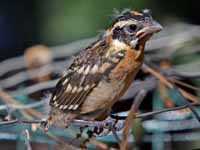

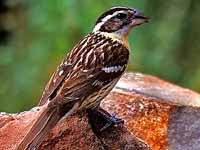
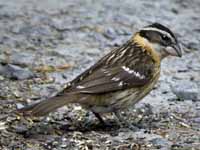
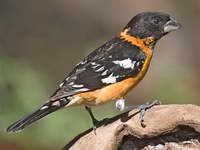
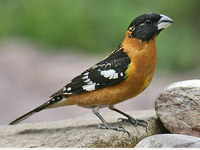
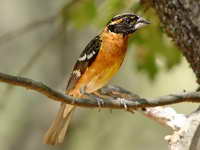
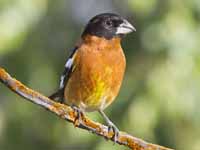
Grosbeak,_Black-thighed Pheucticus tibialis
Description: The male is yellow with a black back, wings, thighs, and tail. The female is duller. Both sexes have a white wing patch, which is smaller on the female.
Range: From Costa Rica to western Panama.
Habitat: Semi-open habitats included forest canopy, secondary forest, woodland edges, wooded pastures, and suburban gardens.
Consevation status: Least concern.
Image by: 1) Jerry Oldenettel - Costa Rica 2) Cornell_Univ's_Neotropical_Birds_Online - Rual_VegaRange: From Costa Rica to western Panama.
Habitat: Semi-open habitats included forest canopy, secondary forest, woodland edges, wooded pastures, and suburban gardens.
Consevation status: Least concern.
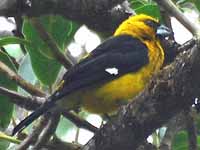
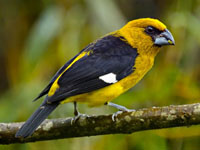
Grosbeak,_Golden-bellied also Southern Yellow Grosbeak Pheucticus chrysogaster
Description: The male is bright yellow with black wings and a black tail. The female is dull yellow with brown wings and dingy streaks. Both sexes have white spots on the wings and tail.
Range: It is found in north-western South America, including Trinidad and Tobago.
Habitat: Tropical and subtropical dry forests, montane forests, and shrublands. They also occur in degraded former forests.
Consevation status: Least concern.
Image by: 1) David Cook - Peru 2, 3) Nick Athanas - Peru, Ecuador Range: It is found in north-western South America, including Trinidad and Tobago.
Habitat: Tropical and subtropical dry forests, montane forests, and shrublands. They also occur in degraded former forests.
Consevation status: Least concern.


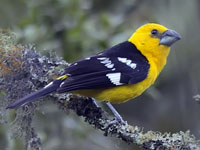
Grosbeak,_Rose-breasted Pheucticus ludovicianus
Description: The breeding male has a black head and upperparts with white wing patches, white, white underparts, and a conspicuous rose-red breast patch. The female is brownish-grey above with paler, streaked underparts.
Range: They are native to central and northeast America, including Canada.The northern populations migrate south for the winter to central and northern South America.
Habitat: Open deciduous woodlands.
Consevation status: Least concern.
Range: They are native to central and northeast America, including Canada.The northern populations migrate south for the winter to central and northern South America.
Habitat: Open deciduous woodlands.
Consevation status: Least concern.
Image by: 1) Norm Townsend - Oklahoma 2) Cephas - Quebec, Canada 3) Jerry Downs - Indiana 4) nebirdsplus 5) J J Harrison 6) Cornell_Univ's_Neotropical_Birds_Online - Michel_Bourque 7) New Jersy Birds 8) Dick Daniels - New Hampshire
1) Juvenile 2) Juvenile male 3, 4) Female 5, 6, 7) Male
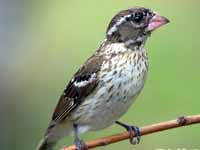
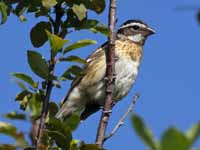

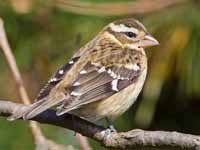


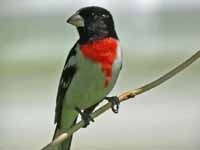

Grosbeak,_Yellow also Mexican Yellow Grosbeak Pheucticus chrysopeplus
Description: The male has a yellow back, head, and underparts. Its black wings and tail have large white spots. The female has olive upperparts with dark streaks on the crown and back and smaller white spots on the wings.
Range: Native to Mexico with occasional vagrants in the United States. The Sonora populations are migratory.
Habitat: They inhabit forests, woodlands, and forest edges.
Consevation status: Least concern.
Image by: 1) M_van_Ree 2) Dick Daniels - Desert Museum aviary in Arizona 3) Arjan Haverkamp - Burgers Zoo, Arnhem, Netherlands 4) Tom
Friedel (BirdPhotos.com) - Miami Metrozoo Range: Native to Mexico with occasional vagrants in the United States. The Sonora populations are migratory.
Habitat: They inhabit forests, woodlands, and forest edges.
Consevation status: Least concern.
1) Female 2 - 4) Male
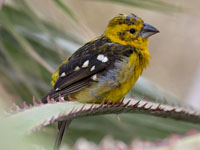
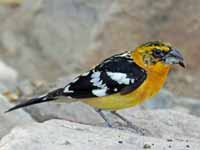

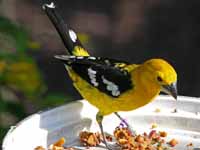
Genus Rhodothraupis - 1 species
Grosbeak,_Crimson-collared Rhodothraupis celaeno
Description: Males have black upperparts and a black hood with a dull red nape, shoulders, and mottled belly. Females are olive-green above and yellow below with a black face. Crimson collared grosbeaks have large, black bills.
Range: From southern Texas to north-eastern Mexico.
Habitat: Tropical lowland forest, secondary forest, and forest edges.
Similar to: Varied Bunting. Male Crimson-collared Grosbeak has a black head; male Varied Bunting have a blue forehead.
Consevation status: Least concern.
Image by: 1) jpc Raleigh 2) Cornell_Univ's_Neotropical_Birds_Online - Earl_Horn in TexasRange: From southern Texas to north-eastern Mexico.
Habitat: Tropical lowland forest, secondary forest, and forest edges.
Similar to: Varied Bunting. Male Crimson-collared Grosbeak has a black head; male Varied Bunting have a blue forehead.
Consevation status: Least concern.
1) Female 2) Male

